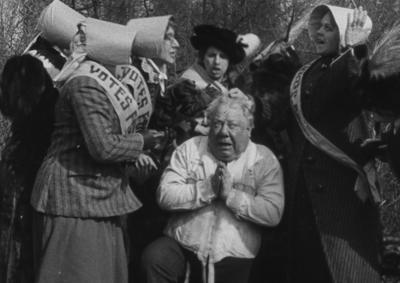The decade of the 1910s was an exciting time of transformation for the American film industry. The era would witness film exhibition’s evolution from modest storefront nickelodeons into larger and more comfortable venues, while majestic movie palaces began rising against the skylines of the nation’s larger cities. The independent film producers proved victorious over the monopolistic Motion Picture Patents Company, and this success engendered the creation of a number of major studios still operating today. Movie production commenced its migration from New York and New Jersey to the favorable climate of diversely scenic California, while studios embraced the previously forbidden practice of revealing the names of their actors and actresses, thereby creating the first movie celebrities. As movie production techniques matured, films began to grow longer in length with increasingly complex narratives, and the resultant ‘”feature film” eventually captured the imagination (and pocket money) of the film-going public.
Even amidst this tumult of change, the short film remained a popular and relevant ingredient of the film-going experience, although its use in theatrical presentation was subsequently redefined into a supporting role. This evening’s program consists of a diverse mix of shorts from the 1910s recently restored and preserved by UCLA Film & Television Archive. Highlights include Mother of the Ranch, one of the earliest surviving examples of Allan Dwan’s directorial work, featuring future star Wallace Reid in an early role; A Railroad Engineer featuring John Halliday, perhaps best remembered today as the philandering father in The Philadelphia Story (1940); the Harold Lloyd comedy A Jazzed Honeymoon, directed by Hal Roach and co-starring Harry ‘Snub’ Pollard and Bebe Daniels; the Vitagraph ‘Bunnyfinch’ comedy Bunny As A Reporter, starring John Bunny and Flora Finch; and episode 4 (“The Love Liar”) of the didactic drama series Who Pays?, starring Ruth Roland and Henry King, who also co-directed and wrote the series.
Steven K. Hill
Musical accompaniment will be provided by Robert Israel.
Preservation funded by The Packard Humanities Institute
The Star of the Sideshow (1912)
35mm, b/w and tinted, silent, approx. 12 min.
Preserved from a 35mm nitrate print. Laboratory services by The Stanford Theatre Film Laboratory.
Preservation funded in memory of David Holland
Mother of the Ranch (1911)
Directed by Allan Dwan. American Film Manufacturing Company. With: J. Warren Kerrigan, Pauline Bush, Jack Richardson, Louise Lester, George Periolat, Wallace Reid. 35mm, b/w, silent, approx. 11 min.
Preserved from a 35mm nitrate print. Laboratory services by The Stanford Theatre Film Laboratory.
Preservation funded by The AFI/NEA Film Preservation Grants Program, The Packard Humanities Institute
Sammy Orpheus (1915)
Directed by Tom Santschi. Selig Polyscope Company. Screenwriter: Lanier Bartlett. With: Bessie Eyton, Harry Lonsdale, Bella Riddell. 35mm, b/w and tinted, silent, approx. 11 min.
Preserved from a 35mm nitrate print. Laboratory services by Film Technology Company, Inc., The Stanford Theatre Film Laboratory.
Preservation funded by Beth Wallis, The Packard Humanities Institute
A Railroad Engineer (1912)
Lubin Manufacturing Company. Producer: Siegmund Lubin. With: John Halliday, May Buckley. 35mm, b/w and tinted, silent, 12 min.
Preserved in cooperation with Archive Film Agency from a 35mm nitrate print. Laboratory services by Film Technology Company, Inc., The Stanford Theatre Film Laboratory.
Preservation funded by The Packard Humanities Institute
A Jazzed Honeymoon (1919)
Directed by Hal Roach With: Harold Lloyd, “Snub” Pollard, Bebe Daniels, Sammy Brooks, Mildred Forbes. 35mm, b/w, silent, approx. 11 min.
Preserved from a 35mm acetate fine grain master positive. Laboratory services by The Stanford Theatre Film Laboratory. Special thanks to Suzanne Lloyd.
Preservation funded by The Packard Humanities Institute, The AFI/NEA Film Preservation Grants Program
Bunny as a Reporter (1913)
Directed by Wilfrid North. Vitagraph Company of America. Screenwriter: Beta Breull. With: John Bunny, Flora Finch, Charles Eldridge, Tom Sutton. 35mm, b/w, silent, approx. 8 min.
Preserved in cooperation with Warner Bros. from the 35mm nitrate original picture negative. Laboratory services by Film Technology Company, Inc., The Stanford Theatre Film Laboratory.
Preservation funded by The Packard Humanities Institute
Across the Hall (1916)
Directed by Mack Sennett, Ford Sterling. Keystone Film Company. Producer: Mack Sennett. With: Ford Sterling. 35mm, b/w, silent, approx. 9 min.
Preserved in cooperation with Archive Film Agency from two incomplete 35mm nitrate prints. Laboratory services by The Stanford Theatre Film Laboratory.
Preservation funded by Saving the Silents, a Save America’s Treasures project organized by the National Film Preservation Foundation, the National Endowment for the Arts, the National Parks Service, Department of the Interior; The Packard Humanities Institute
Who Pays? Chapter 4 – The Love Liar (1915)
Directed by Harry Harvey. Balboa Amusement Producing Company. Producers: E. D. Horkheimer and H. M. Horkheimer. Screenwriter: Will M. Ritchey. With: Henry King, Ruth Roland, Daniel Gilfether. 35mm, tinted, silent, approx. 35 min.
Preserved from a 35mm nitrate print. Laboratory services by Film Technology Company, Inc., Triage Motion Picture Services, The Stanford Theatre Film Laboratory.






 Mobile Navigation
Mobile Navigation

